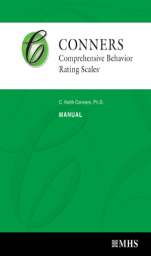| ||||||
| |||||||||||||||||||||
|
| |||||||||||||||||||||||||||||||||||||||
|
Conners Comprehensive Behavior Rating Scales (Conners CBRS)
by C. Keith Conners, Ph.D.
Three Sources of Information
The CBRS is composed of three rating scales: one completed by the teacher (204 items), one by the parent or caregiver (203 items), and one by the student being evaluated (179 items). The teacher and parent scales, written at a fourth-grade reading level, can be used to assess students 6 through 18 years of age. The self-report scale, written at a third-grade level, is appropriate for 8- through 18-year-olds.
A Broad Spectrum Assessment
The three CBRS forms cover the following scales:
DSM-IV-TR Symptom Scales
Empirical Scales |
• Emotional Distress • Aggressive Behaviors • Academic Difficulties • Hyperactivity or Hyperactivity/Impulsivity • Separation Fears • Social Problems • Perfectionistic and Compulsive Behaviors |
Validity Scales |
• Positive Impression • Negative Impression • Inconsistency Index |
Rational Scales |
• Violence Potential • Physical Symptoms |
The Empirical Scales identify a wide range of emotional, behavioral, and academic problems; the Rational Scales alert you to the student’s potential for violence; and the DSM-IV-TR Symptom Scales support formal diagnosis by linking symptoms to established diagnostic criteria.
Critical Items and Indicators
While scale scores are important, useful information can be derived from specific items as well. These items, along clinical indicators, reveal issues that may warrant further investigation severe conduct, self harm, functional impairment, bullying, panic attack, post-traumatic stress disorder, enuresis/encopresis, pervasive developmental disorder, specific phobia, substance use, tics, and more.
Clinical Index
The CBRS also includes a 25-item Clinical Index, which tells you how likely it is that a given child will have a clinical diagnosis. Completed in less than 5 minutes, it is useful when you are monitoring treatment progress and must assess the child repeatedly. Although it is included on the teacher, parent, and self-report forms, the Clinical Index can also be purchased separately.
Unlimited-Use Computer Scoring
Because the CBRS is such a comprehensive test, it must be computer scored. With unlimited-use software, you can quickly score the test and generate a variety of helpful reports that provide clear links to DSM-IV-TR diagnostic criteria and IDEA eligibility indicators. Portions of these reports can be cut and pasted into your own documents, allowing you to create individualized narratives for each student assessed.
A Single Instrument Answering Diverse Needs
No matter how diverse your students or young clients are, the CBRS can help you identify their problems or determine their diagnoses. It can tell you who qualifies for special services, which interventions are likely to be effective, and how well treatment is working. This single assessment addresses a multitude of problems and guides you toward individualized solutions.
Component:
SOFTWARE KIT: Includes Unlimited-Use Scoring Software Installation (USB Key); 25 Teacher Response Booklets; 25 Parent Response Booklets; 25 Self-Report Response Booklets; 1 Manual. Required: PC with Windows 98 or above (including Vista)




